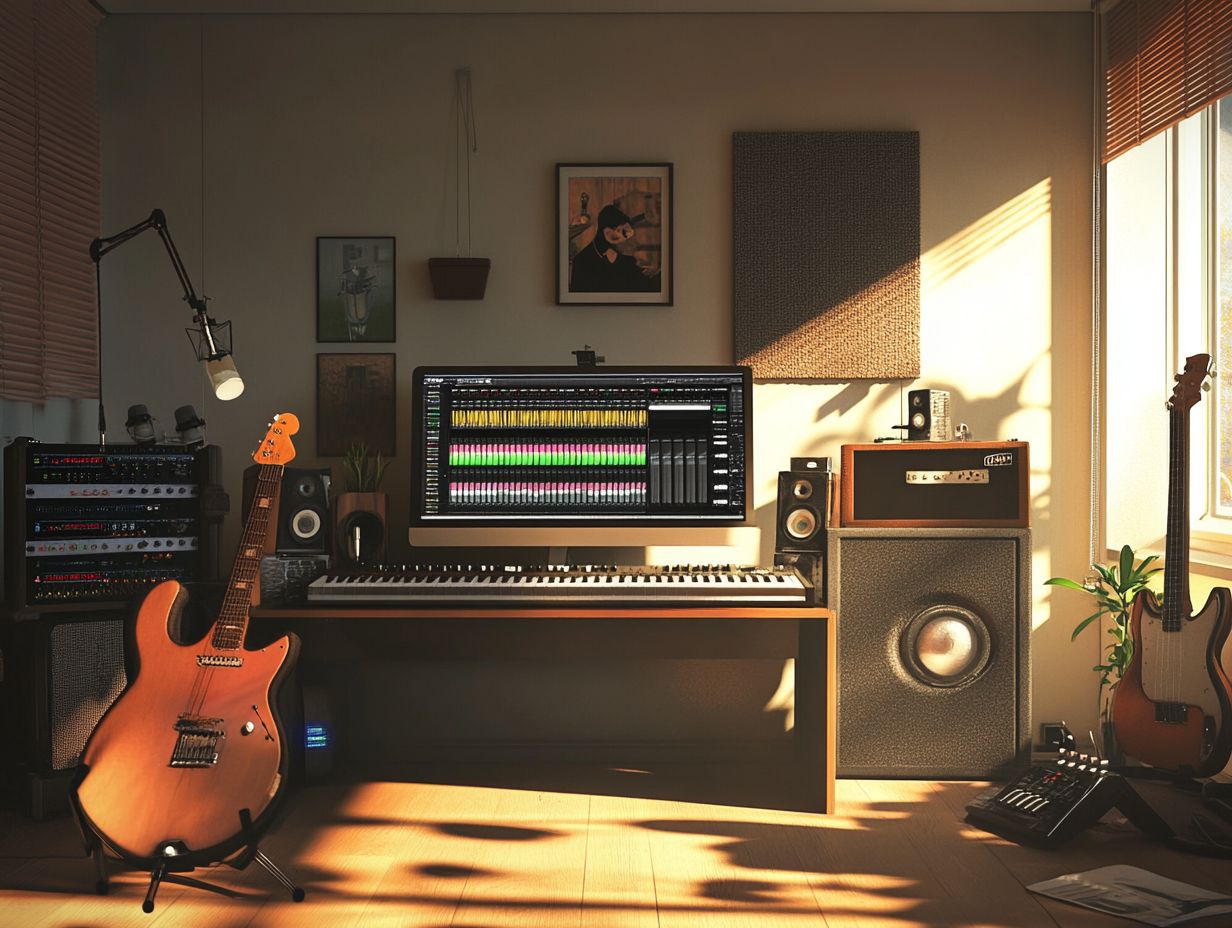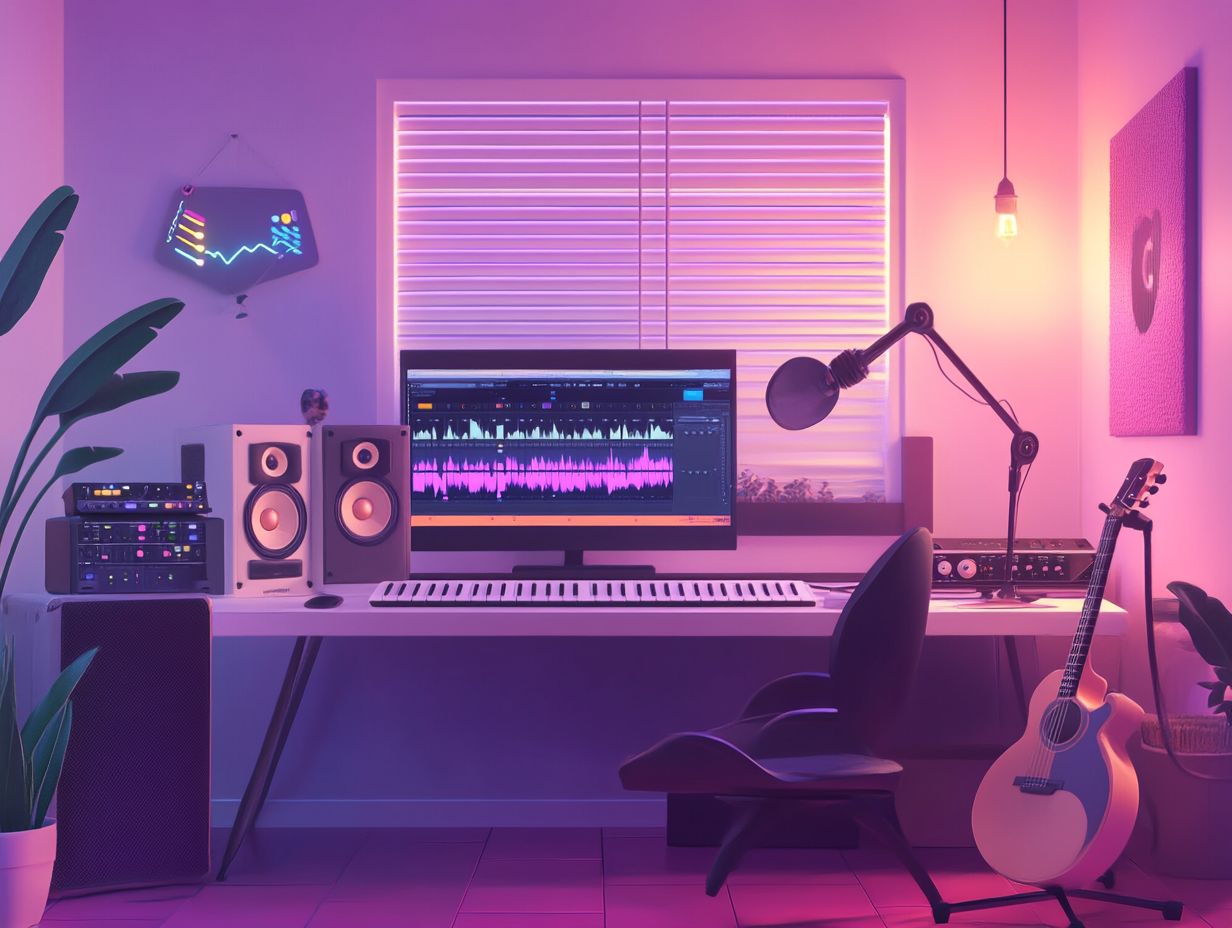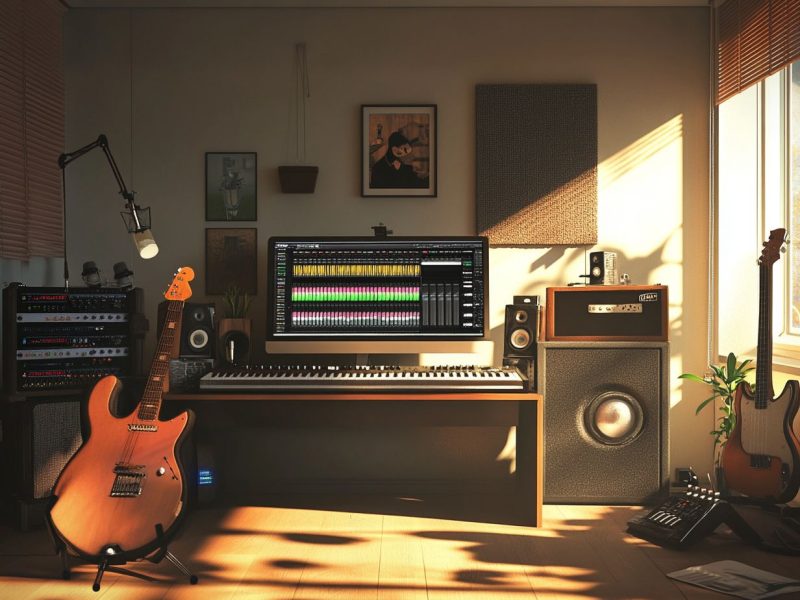Creating a home studio represents an advantageous initiative for musicians, podcasters, and content creators.
This guide examines the numerous benefits associated with establishing a personal recording space, ranging from increased creativity to significant cost savings. It addresses essential equipment, including microphones and software, while offering recommendations for optimizing the setup to achieve optimal sound quality.
Readers will gain insights into effective recording techniques, mixing and mastering strategies, as well as methods for promoting studio services.
Whether one is a beginner or seeking to enhance an existing setup, this guide provides valuable information for all levels of experience.
Benefits of Having a Home Studio

Establishing a home recording studio provides numerous advantages for both aspiring musicians and experienced professionals, facilitating music production, encouraging creative workflows, and enabling the recording of high-quality sound without the logistical challenges associated with traditional studios.
This self-contained environment not only fosters creativity but also allows for significant experimentation with various recording techniques. With essential studio components such as audio interfaces, microphones, and soundproofing materials readily available, artists can achieve pristine sound quality with minimal external interference.
The presence of digital audio workstations (DAWs) within a home setup allows for seamless track layering, mixing, and mastering, thereby enhancing the potential for producing polished final products. Moreover, musicians can tailor their studio environment with virtual instruments and plugins, broadening their sonic palette while benefiting from a learning curve aligned with their specific needs.
A dedicated home space promotes artistic exploration and growth in ways that are both financially viable and logistically manageable.
Essential Equipment for a Home Studio
Establishing an effective home studio setup necessitates an investment in essential recording equipment, as this significantly impacts the quality of audio recordings and the overall music production experience.
Key components include:
- A reliable audio interface
- High-quality microphones—specifically condenser and dynamic types
- Studio monitors that provide accurate sound playback
Furthermore, the incorporation of headphones, mixing consoles, and pop filters is vital to ensuring optimal recording conditions, thereby allowing for the capture of sound waves with clarity and precision.
This carefully selected combination of equipment facilitates a productive creative workflow and enhances the ability to produce professional-grade recordings within a home studio environment.
Microphones, Audio Interface, and Monitors
Selecting the appropriate microphones, audio interface, and studio monitors is critical for achieving high recording quality in a home studio, as these components significantly influence the clarity and fidelity of audio projects.
By comprehending the various characteristics and applications of these tools, sound engineers can customize their setups to meet their specific requirements.
For instance, a condenser microphone is frequently favored for vocal recordings due to its sensitivity and wide frequency response, whereas dynamic microphones excel in live settings and are particularly effective for capturing loud instruments.
Audio interfaces serve as the connection between these microphones and the digital domain, ensuring that analog signals are converted into high-quality digital audio.
Simultaneously, studio monitors provide accurate sound reproduction, allowing artists and producers to discern every nuance in their tracks, thereby facilitating the mixing process and ensuring that the final product translates effectively across diverse listening environments.
Software and Plugins
In the field of music production, selecting the appropriate recording software and plugins is essential for optimizing creative potential and achieving professional results within a home studio environment.
For example, users can take advantage of MIDI sequencing features to compose complex arrangements or utilize virtual instruments that emulate traditional sounds, thereby adding depth to their projects. A comprehensive suite of audio editing tools available within these platforms facilitates the process, enabling artists to manipulate waveforms, apply equalization, and refine their tracks with precision.
Furthermore, the use of third-party plugins, such as compression and reverb effects, can substantially enhance audio quality, imparting a polished, radio-ready sound to recordings. With the right combination of software and plugins, creators can experience a seamless production process that fosters innovation and artistic expression.
Setting Up Your Home Studio
Establishing an effective home studio necessitates meticulous planning and consideration of several key factors, including studio space, acoustic treatment, and soundproofing, to create an optimal recording environment.
Proper acoustic treatment is essential for managing sound waves effectively; it reduces undesirable reflections and enhances the clarity of recorded audio.
Furthermore, implementing soundproofing measures is crucial for minimizing external noise interference, thereby facilitating focused recording sessions free from distractions.
By developing a well-structured studio workflow, individuals can significantly enhance their productivity and creativity throughout the recording, mixing, and mastering processes.
Room Acoustics and Soundproofing

Achieving optimal room acoustics and effective soundproofing is essential for enhancing the recording quality of a home studio, as these factors significantly influence the clarity and fidelity of sound recordings.
One effective technique for improving room acoustics involves the use of acoustic panels, which absorb excessive sound reflections and diminish echoes, resulting in a more balanced sound. Additionally, strategically placed bass traps in the corners can mitigate low-frequency buildup, further refining the listening environment. The incorporation of diffusers can also assist in scattering sound waves evenly, thereby preventing excessively bright or dull spots within the room.
Furthermore, implementing soundproofing measures—such as utilizing dense materials, installing double-glazed windows, and ensuring sealed doorways—will minimize external noise interference. Collectively, these strategies not only optimize the sonic characteristics of the space but also elevate the overall production quality, enabling the artist’s vision to be realized with greater precision.
Optimizing Your Equipment Setup
Optimizing the equipment setup in a home studio requires careful attention to signal flow, monitoring, and the arrangement of all components to ensure seamless interaction among various recording devices.
By focusing on these critical aspects, artists can effectively minimize noise and latency, thereby fostering a more productive environment. For example, positioning studio monitors at ear level and employing acoustic treatment can significantly enhance sound accuracy.
Additionally, the use of color-coded cables and properly labeled inputs can facilitate streamlined workflows, enabling efficient troubleshooting.
Prioritizing an organized layout not only improves visual aesthetics but also greatly enhances functionality, making it easier for users to navigate their equipment during creative sessions.
These strategic adjustments collectively support a smoother recording experience, allowing for uninterrupted creativity.
Recording Techniques and Tips
Mastering a range of recording techniques is crucial for achieving professional-quality audio in any project, whether one is involved in track recording, multitracking, or specifically recording vocals and instruments.
A comprehensive understanding of the nuances of various methods can significantly enhance one’s ability to capture a diverse array of sounds and produce rich, layered compositions.
For example, employing the appropriate production equipment and implementing effective microphone placement can greatly impact the clarity and depth of recordings, ultimately resulting in a more polished final product.
Mic Placement and Recording Process
Effective microphone placement is a fundamental aspect of the recording process, significantly impacting the quality of sound waves captured during sessions in a home studio. Proper positioning of microphones—whether placed in an isolation booth or a dedicated vocal booth—can enhance the clarity and presence of both vocals and instruments.
A thorough understanding of various recording techniques, coupled with experimentation regarding distance and angle, can facilitate the achievement of optimal sound quality, thereby enabling the production of high-quality recordings that align with artistic objectives.
When positioning a microphone, it is important to consider the acoustics of the environment, as reflections from walls and other hard surfaces can alter the sound. For example, placing a microphone too close to an instrument may introduce undesirable bass frequencies, commonly referred to as the proximity effect, whereas positioning it too far away can result in a loss of detail in the sound.
A valuable technique to implement is the ‘three-to-one rule,’ which suggests that when utilizing multiple microphones, they should be placed three times as far apart from each other as they are from the sound source. This principle effectively minimizes phase issues that could compromise the clarity of the recording.
Additionally, experimenting with different types of microphones, such as dynamic or condenser microphones, can significantly influence the captured sound, enriching the depth and character of the final mix.
Troubleshooting Common Issues
Troubleshooting common issues within a home studio can significantly enhance recording quality and ensure that equipment operates optimally during sessions. Problems such as unexpected equipment malfunctions, poor signal flow, or faulty audio cables can impede the creative workflow. By familiarizing oneself with potential challenges and their corresponding solutions, one can swiftly resolve issues and maintain a productive recording environment conducive to seamless audio production.
Many aspiring musicians and sound engineers face obstacles that range from inadequate acoustic treatment to software glitches, which can compromise the integrity of their projects. To address these challenges effectively, it is essential to conduct regular inspections and maintenance of the setup, replacing worn cables and updating software to prevent disruptions.
Implementing noise isolation techniques and utilizing high-quality preamps can also result in a significant improvement in sound clarity.
Furthermore, creating a checklist for session preparation can ensure that all elements are in order, facilitating a smoother workflow and allowing for more time dedicated to creativity and exploration.
Mixing and Mastering in a Home Studio

Mixing and mastering in a home studio are vital stages in the music production process, necessitating a thorough understanding of mixing techniques and the mastering process to ensure that tracks attain the desired sound quality.
The effective use of software plugins and studio monitors can greatly enhance audio mixing capabilities, enabling precise adjustments in equalization, compression, and reverb to refine the sound.
Establishing a robust workflow during these stages is essential for producing polished, professional-sounding music that resonates effectively with the audience.
Software and Techniques for Mixing and Mastering
Utilizing the appropriate software and techniques for mixing and mastering is crucial for achieving high-quality audio in a home studio setting.
Contemporary music producers have access to a wide range of software options, each specifically designed to assist in the complex process of mixing and mastering. For example, widely used Digital Audio Workstations (DAWs) such as Ableton Live, Logic Pro, and Pro Tools offer integrated tools that facilitate intuitive audio manipulation, including equalization adjustments, compression, and reverb effects.
Specialized mastering suites, such as iZotope Ozone and Waves’ Mastering Bundle, provide advanced algorithms capable of analyzing and optimizing audio for various platforms, thereby ensuring that the final output is both polished and professional.
By employing these cutting-edge programs, sound engineers can effectively implement mixing techniques, such as balancing, panning, and frequency management, significantly enhancing the overall production quality of their music.
Promoting Your Home Studio and Services
Effectively promoting a home studio and its services is essential for establishing a robust client base and attracting new projects, particularly within the competitive field of music production.
By implementing strategic marketing initiatives and utilizing online collaboration tools, one can effectively showcase their skills and portfolio to prospective clients, thereby facilitating collaboration in various musical genres.
Additionally, engaging through social media, networking within music communities, and providing promotional rates can significantly enhance visibility and bolster professional reputation.
Building a Client Base and Marketing Strategies
Building a client base for a home studio necessitates the implementation of effective marketing strategies and proactive networking to connect with potential clients and demonstrate services offered.
This strategic approach underscores the significance of comprehensively understanding the target audience while also emphasizing the necessity of leveraging multiple outreach channels.
For example, collaborating with local musicians and other creative professionals can yield mutual benefits, expanding the networks of both parties involved.
Establishing a professional website and maintaining an active presence on social media platforms such as Instagram and Facebook is essential, as these tools facilitate the showcasing of work and client testimonials. Additionally, participating in local music events and festivals significantly enhances visibility, ensuring that the services offered remain prominent in the minds of potential clients.
By integrating creativity with fundamental marketing principles, the process of building a client base becomes a more attainable and rewarding endeavor.
Frequently Asked Questions
What equipment do I need to set up a home recording studio?

To set up a home recording studio, you will need a computer, audio interface, microphone, headphones, studio monitors, and recording software. You may also want to consider additional equipment such as a MIDI keyboard, microphone stand, and acoustic treatment for your room.
Do I need a dedicated room for my home recording studio?
While having a dedicated room for your home recording studio is ideal, it is not always necessary. You can still set up a functional studio in a spare bedroom or even a corner of a room. Just make sure the space is quiet, well-ventilated, and has enough room for your equipment.
What is the best recording software to use for a home recording studio?
The best recording software for a home studio will depend on your personal preferences and the type of music you want to create. Popular options include Pro Tools, Logic Pro, and Ableton Live. It’s recommended to try out a few different options before deciding which one works best for you.
How do I connect my equipment to my computer for recording?
You will need to use an audio interface to connect your equipment to your computer. This acts as a bridge between your analog or digital equipment and your computer. Simply connect your microphone, headphones, and studio monitors to the designated ports on the audio interface, and then connect the interface to your computer via USB or FireWire.
What is the purpose of studio monitors and do I need them?
Studio monitors are specialized speakers designed for accurate and clear playback of audio recordings. They are essential for mixing and mastering your music as they provide a more accurate representation of your sound compared to regular speakers. While they are not a necessity for a home recording studio, they are highly recommended for professional-quality results.
How can I improve the acoustics of my home recording studio?
Acoustic treatment is crucial for creating a clean and balanced sound in your home recording studio. This can include sound-absorbing panels, bass traps, and diffusers placed strategically around the room to reduce unwanted echoes and reflections. You can also use furniture and bookshelves to help absorb sound and break up standing waves in the room.


 Top 10 Keyboard Stands for Stage: Enhance Your Performance!
Top 10 Keyboard Stands for Stage: Enhance Your Performance!